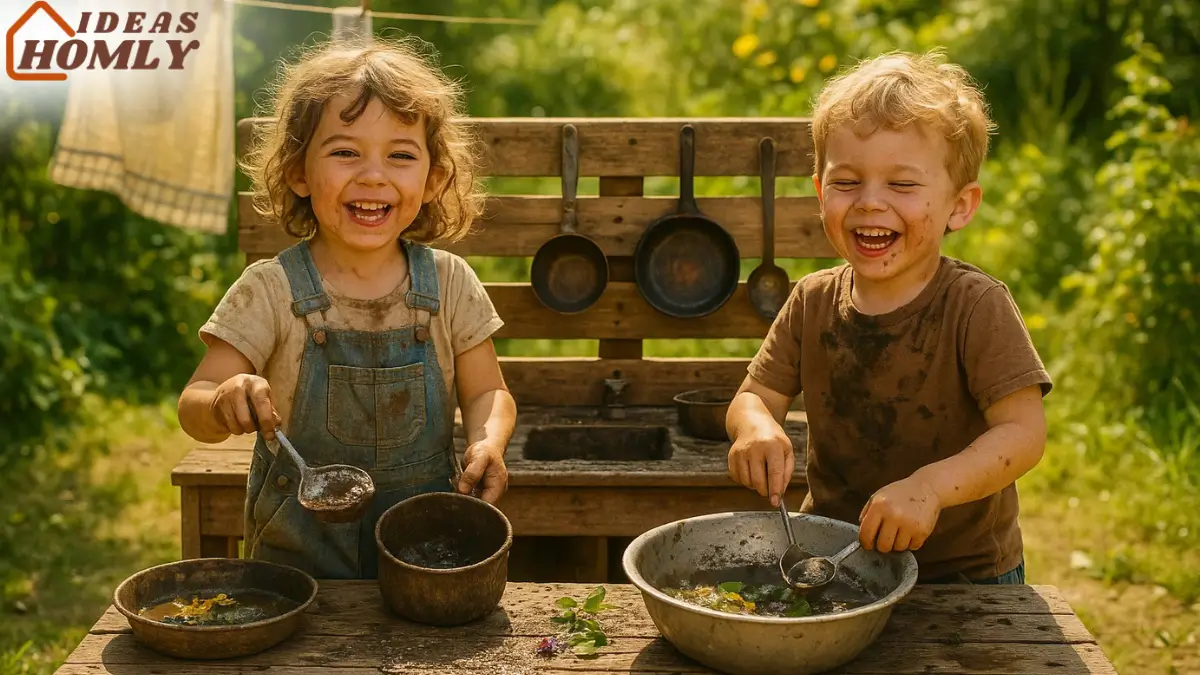I’ll be honest, there was a time when I really hated seeing mud. With two restless kids bouncing off the walls, clinging to tablets, and complaining about boredom, I felt stuck.
Screens were becoming the go-to babysitter, and I hated that. I craved something better for my children something real, something that felt like the wild, messy, imaginative play of my own childhood.
Then one afternoon, in the middle of my parenting desperation, a friend casually suggested setting up a mud kitchen. I laughed at first. Let them play with dirt? With actual mud? But deep down, it stirred something nostalgic in me.
I remembered how happy I was as a child, making “soup” from grass clippings and “cakes” out of mud and dandelions. That memory alone was enough to give it a shot.
We grabbed some old pots, a beat-up spoon, a plastic tub, and a patch of soil. No Pinterest-worthy setup just a space to dig, pour, and play. And honestly? It changed everything.
Our backyard transformed into a joyful mess of creativity. My kids were outdoors for hours, completely immersed in their imaginary café, serving leaf stew and muddy muffins with pride.
They were laughing. They were learning. They were playing. And I, for the first time in a long time, breathed a sigh of relief.
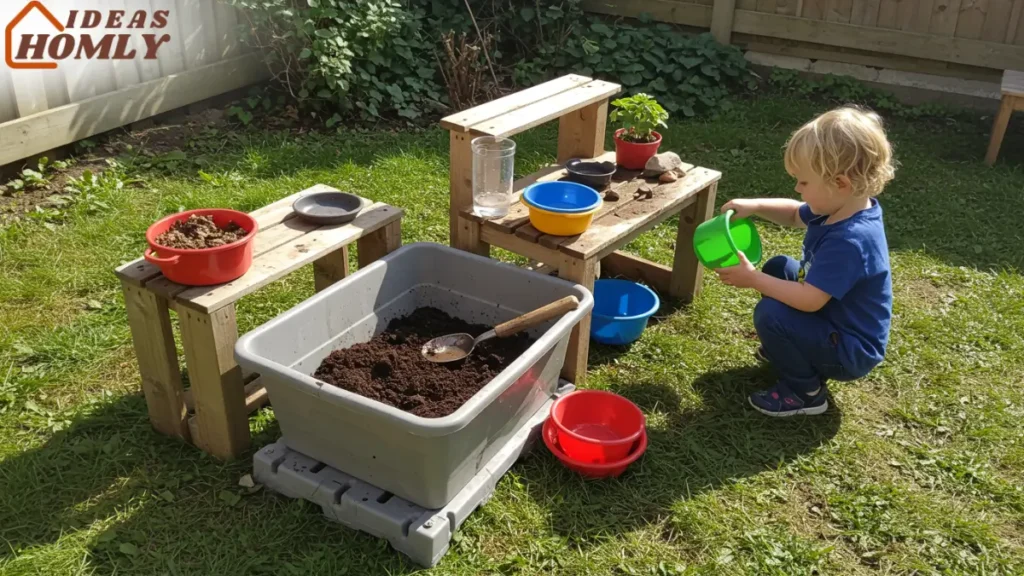
That little mud kitchen became the most loved corner of our yard and a total parenting game changer. I want to share with you why mud kitchens are so much more than a fun activity.
They’re packed with developmental benefits, spark creativity, reduce screen time, and bring real joy back into play.
You’ll also love this article: Summer Mud Kitchen Ideas
Why Mud Kitchens Are So Good for Kids (and Us)
A mud kitchen might seem like just a messy outdoor distraction. But in reality, it’s a goldmine for child development endorsed by educators, therapists, and exhausted parents alike.
It blends sensory play, creativity, fine motor skills, STEM learning, and social growth all into one muddy, magical package.
Here’s what I noticed immediately after introducing a mud kitchen at home:
- My kids spent more time outside.
- They argued less and played together more.
- They started using new words, asking questions, and problem-solving in real-time.
- And yes, the screens gathered dust.
Let’s discuss the biggest benefits and why I now recommend mud kitchens to every parent who’s tired of “indoor-only” play.
1. Sensory Play: Hands-On Learning That Sticks (Literally!)
Mud kitchens are the ultimate sensory playground. Every squish, splash, pour, and pat is a chance to learn through touch, smell, sight, and even sound.
I’ve watched my kids marvel as they pour water into dry soil and witness the magical transformation into mud. It’s hands-on, dirty, and deeply engaging.
Research shows that sensory play helps develop neural pathways, improves emotional regulation, and supports cognitive development, especially in early childhood. Mud kitchens make this kind of learning so natural.
Kids feel the difference between gritty sand and smooth mud, listen to the sound of a squelchy stir, and watch as leaves float or sink in their homemade stew. Every new texture, sound, and smell becomes part of how they understand the world.
And let me tell you, mud makes kids happy. There’s actually science behind this: soil contains harmless bacteria that may trigger the brain to release serotonin, a mood-boosting chemical. So yes, playing in mud is literally good for your child’s mental health.

I’ve also noticed how inclusive it is. My toddler just loves patting the mud with her hands, while my preschooler takes charge of mixing “recipes.”
Every child engages with the experience at their own level. Whether they’re sensory-seekers or more hesitant explorers, mud kitchens offer a way to safely (and joyfully) explore the senses.
2. Imagination and Creativity
The moment we set up our mud kitchen, imagination exploded. One day, my son was a chef serving stone stew. Next, my daughter ran a fairy bakery selling petal cupcakes. This kind of open-ended pretend play is so rich in learning.
There are no rules in a mud kitchen just possibilities. Children decide the storyline, create their own roles, and solve problems as they go.
It’s unstructured play at its finest, where creativity isn’t boxed in by pre-designed toys or digital scripts. Instead of tapping buttons on an app, they’re narrating their adventures, testing out ideas, and improvising with every muddy stir.
And it’s not just imagination, it’s early literacy in action. I’ve heard my kids saying things like, “We need three cups of mud and a dash of grass.” They talk through what they’re doing, use descriptive language, and even scribble pretend recipes or signs for their “restaurant.” Language blooms in the mud kitchen, effortlessly.
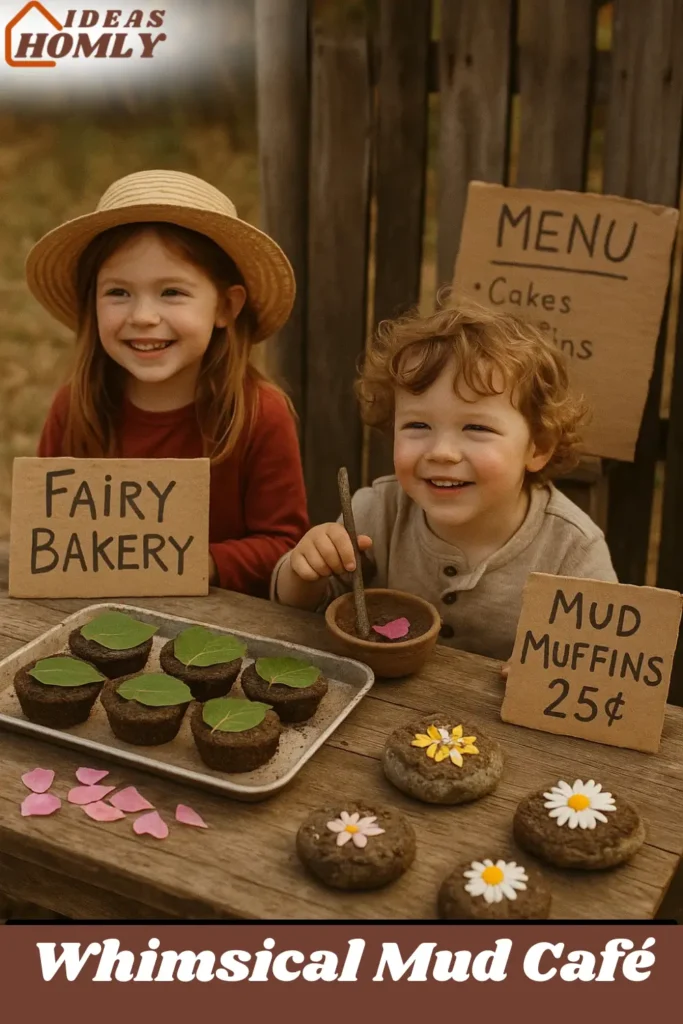
There’s also an artistic side. Mud painting on rocks, sculpting little creatures from wet soil, or arranging natural ingredients into “plated dishes” turns the kitchen into a nature-inspired art studio.
And unlike crafts with a “perfect” end product, mud kitchen art is about the process, not perfection. That builds confidence and encourages self-expression in ways that pre-made toys just can’t.
You might find this helpful: Mud Kitchen Sink Ideas for Backyard Play
3. Social-Emotional Growth: Sharing, Cooperating, and Building Confidence
At first glance, mud kitchens might seem like solo play zones. But the truth? They’re social hubs. Whether it’s siblings, neighbors, or playdates, kids naturally collaborate in their little outdoor kitchen.
I’ve watched my own children go from bickering indoors to playing like a dream team outdoors. One stirs the “soup,” the other gathers “ingredients” from the yard.
They take turns pouring, negotiate over the biggest spoon, and even assign roles: “You be the waiter, I’ll be the chef.” It’s incredible how naturally teamwork and communication develop when kids are immersed in imaginative play.
These shared experiences strengthen:
- Turn-taking and patience
- Listening and expressing ideas
- Empathy and perspective-taking (“Do you think the customer will like my mud pie?” is a real line I’ve heard!)

Mud kitchens also create opportunities for leadership and confidence. I’ve seen my shy child beam with pride while running the “café,” confidently serving pretend meals and explaining her recipes. It’s a chance to practice social scripts and express ideas in a safe, pressure-free setting.
And if your child struggles with social play in structured settings, mud kitchens can be a game-changer.
The freedom of outdoor play combined with the sensory joy of mud seems to level the playing field. Everyone is welcome, everyone gets messy, and everyone connects.
4. Motor Skills: Building Strength and Coordination, Naturally
One of the best things about mud kitchen play is that it keeps little bodies moving. There’s no passive sitting. Kids are digging, lifting, pouring, stirring, squatting, and reaching, all of which build strong muscles and coordination.
Here’s what’s happening behind the scenes:
- Gross motor development (big movements): carrying buckets of water, balancing while gathering rocks, or climbing up to reach a pretend shelf.
- Fine motor refinement (small, precise movements): using spoons to fill muffin tins, picking up pebbles one by one, tying leaves with twine, or pouring water into tiny cups.
These are essential skills not just for physical health, but also for school readiness, especially fine motor control, which supports writing, cutting, buttoning, and more.
I once watched my preschooler scoop mud into a measuring cup, pour it into a cup, and stir it all up with such careful intention. That’s coordination practice, and he didn’t even know it.
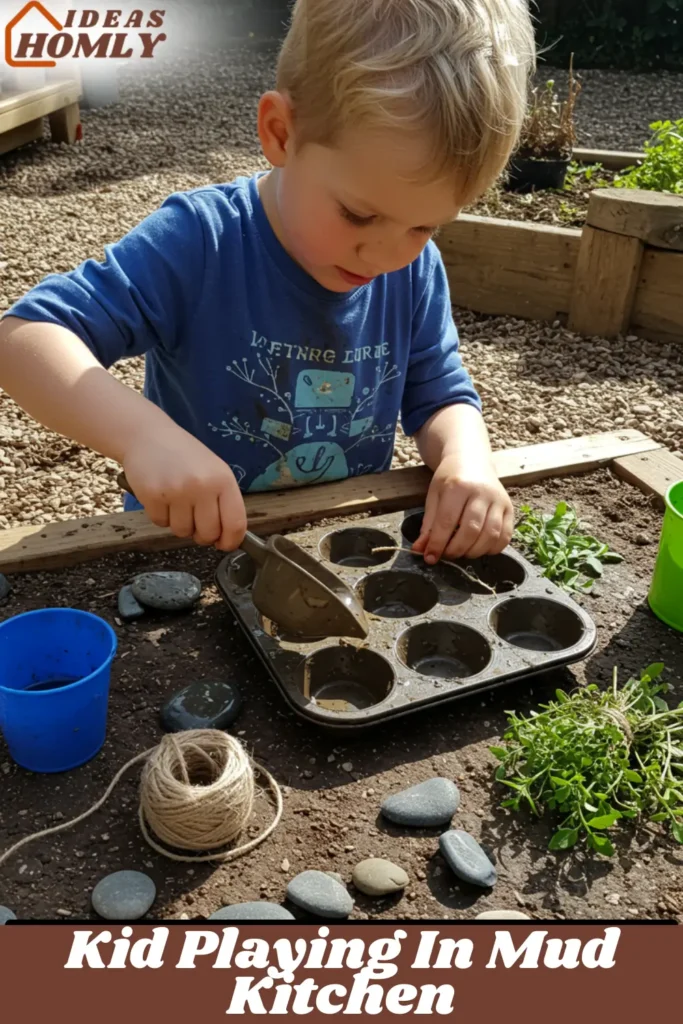
The uneven terrain of outdoor play also adds subtle balance and agility training. Whether they’re crouching to gather leaves or tiptoeing across stepping stones, kids develop core strength and body awareness without a structured workout just through play.
And the best part? They’re so engaged in their own little world, they don’t even realize how much their bodies (and brains) are benefiting.
Here’s something interesting: Mud Kitchen Play Ideas for Kids
5. Nature-Based Learning: STEM and Environmental Awareness in Disguise
Before I had kids, I never thought a simple pile of dirt could teach so much science. But that’s exactly what happens in a mud kitchen.
Children become mini-scientists:
- Mixing soil and water to see what consistency makes the best “pudding”
- Measuring ingredients (“two cups of mud, one pinch of leaves”)
- Observing how water soaks into dirt or how sun dries out a mud pie
- Watching worms wiggle or seeds sprout in a corner they forgot
These aren’t random activities; they’re foundations of STEM learning (science, technology, engineering, and math).
My kids have experimented with cause and effect, made hypotheses, and even explored basic chemistry, all while giggling in a muddy apron.
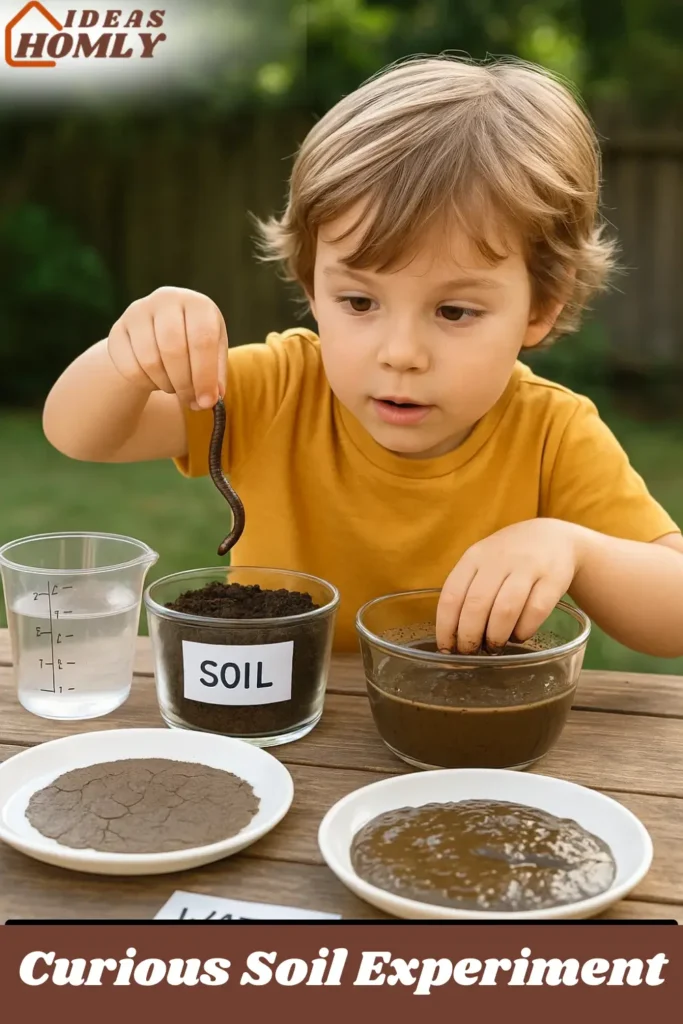
And because they’re interacting directly with nature, mud kitchens spark a deep connection to the outdoors. Suddenly, leaves aren’t just clutter, they’re salad toppings. Rocks become currency. Bugs are guests.
My children now pause to observe ants or gently move worms rather than scream or squish. That’s the beginning of environmental empathy and it starts right at their muddy feet.
Educators often say nature is the best classroom. Mud kitchens prove that point beautifully. Kids learn more through one hour of messy, free play outside than in a dozen worksheets. And better yet, it sticks.
6. Parenting Perks: Screen-Free Joy, Budget-Friendly Fun
Let’s be honest: while we love what’s best for our kids, we also love something that keeps them busy, builds skills, and lets us drink a cup of coffee in peace. That’s exactly what a mud kitchen delivers.
Here’s what I’ve gained since setting one up:
- Less screen time (and fewer battles about it)
- Independent play that lasts for hours
- Minimal costs (ours was nearly free using old kitchen items and soil)
- Easy cleanup (it’s all outside, muddy hands? Hose ’em off!)
- A front-row seat to their imagination that’s more satisfying than any show

Whether you build a simple version from scraps or invest in a ready, made wooden play kitchen, the return on investment is unbeatable.
It grows with your child, adapts to every season (mud pies in summer, leaf soup in fall, snow muffins in winter), and keeps delivering joy long after the novelty of new toys has worn off.
I can honestly say that our mud kitchen has become one of the most valuable “toys” we own, even though we didn’t spend much to create it.
Also Read This Article: How to Build a Mud Kitchen in 3 Easy Steps?
How to Set Up a Mud Kitchen (Without Breaking the Bank)
When I first heard about mud kitchens, I pictured something fancy wooden counters, built-in sinks, designer pots.
But the truth? You can start one with just a bucket of dirt and a spoon. That’s how ours began. From there, we slowly added bits and pieces, and it became our favorite corner of the backyard.
You can read the DIY Outdoor Mud Kitchen Ideas article to find out more and unique ways to set up a mud kitchen for your child.
You don’t need a Pinterest-perfect setup. All you need is:
- A surface for “cooking”: a crate, a pallet, an old bench, or even the ground.
- Tools: spoons, ladles, whisks, bowls, and muffin tins from your kitchen’s donation pile.
- Containers: old pots, pans, buckets, or planters to hold dirt, water, leaves, or flowers.
- A water source: either a garden hose, a water jug, or a plastic bin you can refill.
We started by stacking bricks and a board to make a “countertop.” Then I let the kids add “ingredients” from nature like rocks, leaves, pinecones.

Over time, we included a secondhand metal bowl as a sink and painted a few signs. They even made menus with chalk. It became their little restaurant, science lab, and art studio rolled into one.
You can get creative with storage too, use hanging baskets for utensils, a dish rack for pots, or a small shelf to display “meals.”
Just make sure it’s somewhere outdoors where mess is okay (backyard, patio, balcony, or even a community garden corner).
Seasonal Fun & Easy Play Prompts
Mud kitchens aren’t just for summer. We’ve made leaf tacos in fall, ice soup in winter, and mud smoothies with flower sprinkles in spring. The joy is in rotating materials and inviting new ideas. I often offer a simple prompt to inspire fresh play:
- “Can you make a rainbow salad using only natural colors?”
- “Let’s set up a mud pie bakery today, what’s on the menu?”
- “Can you freeze mud in cupcake liners and make ‘ice cream’?”
- “Try mixing dirt and water into different textures, what happens?”
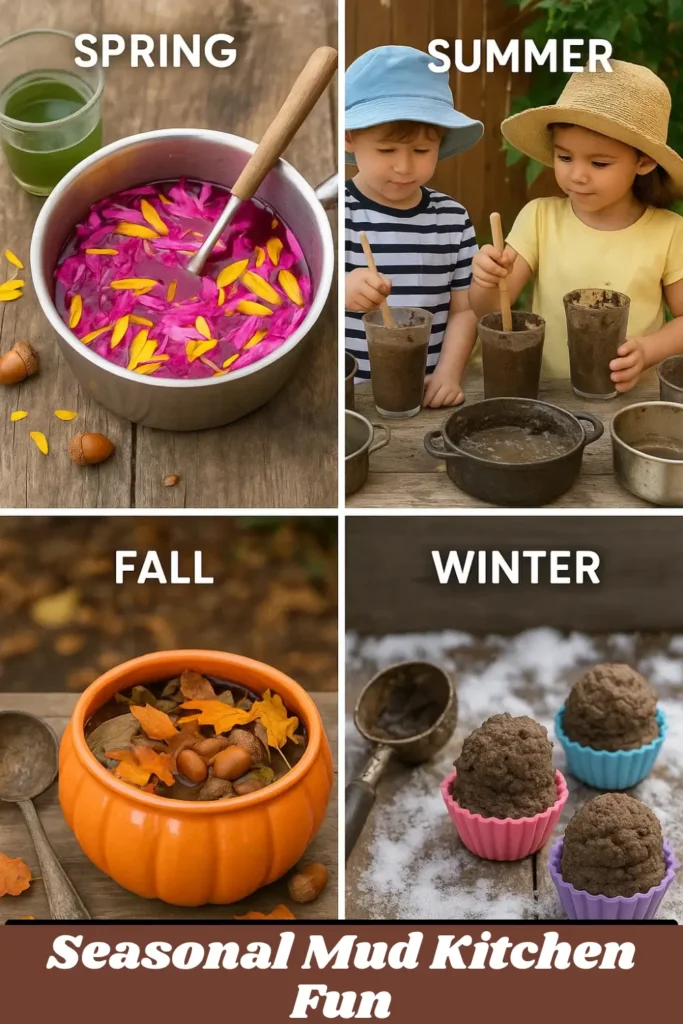
One day we added food coloring to the water, and suddenly we had “berry smoothies” and “chocolate lava cakes.” Another day, I handed them cookie cutters and nature stamps, and they spent an hour crafting shapes in wet sand.
You don’t have to guide every session, just refresh the materials occasionally (bring in herbs, petals, snow, or even citrus peels) and let their imagination do the rest.
Addressing Concerns: Mess, Safety, and Reluctant Kids
Let’s talk about the mess. Yes, it’s muddy. But honestly? It’s way easier to manage than indoor mess.
I keep a bin of “mud clothes” by the back door stained play clothes that are always ready for duty. Afterward, we hose off hands, boots, and any serious grime before heading inside.
Worried about safety? Here’s my quick checklist:
- Use clean soil (no chemicals or animal waste).
- Supervise water play, especially with toddlers.
- Keep small parts safe for younger kids (no choking hazards).
- Have a handwashing station nearby (we use a big water jug with soap).
If your child’s hesitant to get messy, that’s okay! Start small, offer dry ingredients like rice or leaves, or give them gloves and a paintbrush to “decorate” the mud from a distance. Most kids warm up once they see the joy it brings.
Conclusion
I never expected a few pots of dirt to change how my kids played or how I parented. But that little muddy corner became our sanctuary.
It’s where my kids giggle and invent, where they forget about screens, where their shoes get dirty but their minds light up.
A mud kitchen is so much more than play. It’s a learning lab, a social stage, a sensory wonderland, and a heartfelt return to simple joys. It’s low-cost, high-value, and endlessly rewarding for your children and for you.
So grab a bin, some old utensils, and a patch of dirt. Let the kids lead. Let them get messy. Let them learn, laugh, and thrive.
Because in that glorious mud pie mess, something beautiful is growing: your child’s creativity, confidence, connection to nature, and joy.
FAQs
A mud kitchen is an outdoor play area where children can mix mud, water, and nature materials to pretend-cook and explore. You can DIY one using a wooden pallet, old furniture, or even a large bin with some soil and spoons. Just add water, bowls, and let their creativity do the rest!
Toddlers as young as 1.5 years can safely explore mud kitchens with supervision. The ideal age is 3 to 7, when pretend play and sensory curiosity are at their peak but older kids also love it. Play evolves with age, making it a great long-term activity.
Mud kitchen play supports physical, cognitive, and emotional development. Kids build fine motor skills, explore early science and math concepts, and grow socially through teamwork and role-play. It’s a fun and natural way to support holistic learning outdoors.
Use a designated mud outfit or rain gear and have towels or a rinse bucket nearby. Choose clean soil, keep water shallow, and teach basic hygiene like handwashing after play. With a few precautions, cleanup is easy and safety is simple to manage.
Start small by offering dry materials like pebbles, leaves, or rice. Let them lead at their comfort level and skip the mud at first. Many hesitant kids warm up once they see the joy and freedom of messy play, especially when watching others have fun.
Both are great options. A store-bought mud kitchen is sturdy and stylish, but DIY versions are budget-friendly and easy to personalize. Use recycled materials like crates or shelves, it doesn’t need to be fancy. Kids care more about play than appearance!
Rotate play prompts with the seasons like flower soups in spring, leaf stews in fall. Add fun tools, new “ingredients,” or create themes like a mud café or garden bakery. Small changes keep the experience fun and engaging for months to come.

